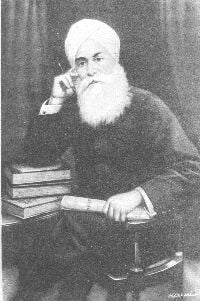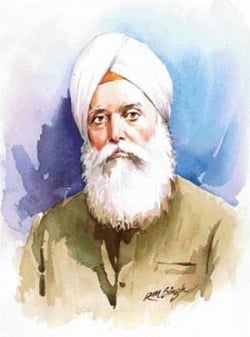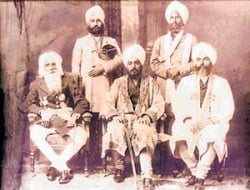Bhai Kahn Singh Nabha on Dasam Granth
Bhai Kahn Singh (Punjabi ਭਾਈ ਕਾਨਹ ਸਿਂਘ ਨਾਭਾ ), of Nabha (30 August 1861- 24 November 1938), is a celebrated scholar and encyclopaedia writer, who was born on 30 August 1861 (Bhadori vadi 10, 1918 Bk), in a Dhillon Jatt family at the village of Sabaz Banera which is about 5 miles from Nabha, in what was then territory of the princely ruler of Patiala. His father was Narain Singh and his mother was Har Kaur. His father was a man of saintly character who became in-charge of Gurdwara Dera Baba Ajapal Singh, at Nabha, on the death in 1861 of his grandfather, Sarup Singh.
Early Life
Bhai Kahn Singh, the eldest of three brothers and one sister, did not attend any school or college for formal education as his father arranged his studies in Hindi, Brij Bhasha and Sanskrit from pandits in and around Nabha who also tutored him in the writing of poetry. By the age of 10, he could recite freely both the Guru Granth Sahib and the Dasam Granth.
He learned music from a famous musicologist, Mahant Gajja Singh. When he was 20 years old he wanted to study Persian. Learning of this, people urged his father, Baba Narayan Singh to not let his son study Persian. Never-the-less, Bhai Sahib sought out Maulawis (Muslim preachers) in Delhi to teach him the language that many of the Sikh Gurus had been proficient in such as the Zafarnama of Guru Gobind Singh.
His Career begins
In 1883 he went to Lahore where during his two year stay he studied Persian texts and assisted Professor Gurmukh Singh, a leading figure in the Singh Sabha, in the publication of his Sudhdrdrak. In 1887 he was appointed tutor to Tikka Ripudaman Singh, the heir apparent of Nabha state. From the Maharaja's private secretary to judge of the High Court, he held several different appointments in the state, serving for a brief interregnum, 1915-17, in the neighbouring Sikh state of Patiala.
In 1885, he had a chance meeting with Max Arthur Macauliffe which led to a lifelong friendship. Macauliffe depended a great deal on his advice and guidance in the work he was then doing on Sikh scriptures and on the history of early Sikhism. He took him along to England when his 6 volume, The Sikh Religion was being printed at the Clarendon Press. Such was his admiration for Bhai Kahn Singh that he assigned to him the copyright of the book.
Literary works
From among Bhai Kahn Singh's works, Gurushabad Ratandkar Mahan Kosh (1930), an encyclopaedia of Sikh literature, will remain a permanent monument to his unmatched industry and erudition. He spent 14 long years writing the Mahan Kosh which is a clear, succinct and wonderful exposition of the history, religion, culture and literature of the Punjab and the Sikhs. This reference book was published through the patronage of the Maharaja Bhupendra Singh of Patiala and is a standard reference text, still in print. It is considered an authentic interpretation of Sikh ethos.
His maiden work, Raj Dharam (1884), written at the instance of Maharaja Hira Singh of Nabha, was followed by Natak Bhavaarth Dipika (1888), an exegesis of extracts from the Hanuman Nalak, based on his notes prepared for the instruction of the young prince under his tutelage.
In 1898, he published Hum Hindu Nahin which set forth forcefully the Singh Sabha standpoint with regard to Sikh identity. The "Gurmat Prabhakar", a glossary of Sikh terminology, concepts and institutions, was published in 1898, and "Gurmat Sudhakar", an anthology of important Sikh texts, scriptural and historical, in 1899. His Guru Chhand Divdkar (1924) and Gur Sabad Alankar (1925) deal primarily with rhetoric and prosody employed in the Guru Granth Sahib and some other Sikh texts.
His Guru Gird Kasauti answers some of the questions raised by his pupil, Tikka Ripudaman Singh, about the meanings of certain hymns in the Guru Granth Sahib, and his Sharab Nikhedh (1907) is a didactic work stressing the harmful effects of drinking. Among his other works are tikas or exegeses of Jameni Asvamedh (1896), Visnu Purana (1903), Steek Chandi di Var (1935).
From among his works which were published posthumously, Gurmat Martand (2 volumes) which essentially follows the formal of his earlier Gurmat Prabhdkar but includes much more explanatory material was published in 1960. A travelogue was published in 1984.
Man of great influence
Bhai Kahn Singh lived in seclusion, totally immersed in his scholarly pursuit, yet his influence transcended the bounds he had created around himself. From the privacy of his study, he continued to enrich contemporary Sikh life in its diverse aspects. A man of aristocratic bearing, he was extraordinarily handsome, with sharp, chiselled features.
He had the interests of an aesthete and loved art, flowers and music. In several spheres, he was the arbiter of taste. Through his writings, he subtly moulded the course of Sikh awakening at the turn of the century. On later day Sikh learning, he has left a permanent imprint.
A True Sikh through and through
Bhai Kahn Singh practised what he preached. He advocated inter-caste marriages and his son’s marriage was such. His niece, a widow, was remarried, in accordance with his wishes. Overall, he lived the life of an erudite country squire. He lived in Nabha, where his great-grandson, Major A P Singh, resides now.
He would retire to the hills of Solan and Simla in summers, and was also known as a good tennis player. He contributed financially and otherwise to the Khalsa College, Amritsar, and presided over the Sikh Educational Conference in 1931, a singular honour. In 1932, the British government gave him the title of Sardar Bahadur. In 1933, he was presented a sword by King Nadir Shah of Afghanistan, where he had gone for research.
Demise of a great literary genius
Bhai Kahn Singh passed away on November 24, 1938, leving behind a rich legacy. Many generations have passed, but this extraordinary scholar still lives through his works.He was given the honorific title of "Sardar Bahadur" in 1933 by, the British government. In 1933, he was presented a sword by King Nadir Shah of Afghanistan, where he had gone to do research.
His keen interest in religious issues touched the life of many and earned the wrath of certain Hindu elements. He was furious and wanted that the Sikh religion and its dictates be taken seriously and depicted correctly. "Hum Hindu Nahin" was published to prove the point.
He was responsible for the removal of all kinds of idols from the Parkarma of Harmandir Sahib, condemning it as idol worship. He always protected truth and fought injustice in all spheres of life. His social and political programs were always directed to fulfil his literary and religious agenda.
Significant works
Raj Dharam (1884)
Nanak Bhavarth Dipika (1888)
Hum Hindu Nahin (1898)
Gurmat Prabhakar (1898)
Gurmat Sudhakar (1899)
Guru Chand Divakar (1924)
Gur Sabad Alankar (1925)
Gur Gira Kasauti (1899)
Sharab Nikhedh (1907)v
Gurushabad Ratanakar Mahan Kosh (1930)
Tikas or exegeses
Jaimant Assamedh (1896)
Visnu Purana (1903)
Sadu and Chandi di Var (1935)
Posthumously published
Gurmat Martand
(2 volumes) (1962)
Bhai Kahn Singh Nabha de Aprakshiet Safarname (1984)
External links
- Punjabi’s pioneering encyclopaedist
- A Tribute to Bhai Kahn Singh Nabha
- Web about Bhai Kahan Singh Nabha------http://www.hvcfoundation.com/



